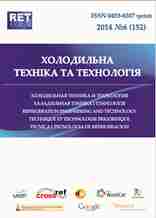НЕЙРОМЕРЕЖЕВЕ ПРОГНОЗУВАННЯ ВЛАСТИВОСТЕЙ ХОЛОДОАГЕНТІВ: ОГЛЯД
DOI:
https://doi.org/10.15673/0453-8307.6/2014.30992Ключові слова:
Штучні нейронні мережі – Властивості холодоагентів – Фазова рівновагаАнотація
В роботі проведено огляд статей, пов'язаних з моделюванням властивостей холодоагентів за допомогою штучних нейронних мереж, що представляють альтернативу прогнозуванню термодинамічних властивостей речовин на основі апарату термодинаміки. У статті обговорюється ефективність, адекватність і обмеження застосування цього підходу.
Посилання
REFERENCES
Zhang G. et al. Forecasting with artificial neural networks // The state of the art. International Journal of forecasting. – 1998. – 14. – pp.35 – 62.
Tayagarajan T. et al. Artificial neural networks: Principles and application to model based control of drying systems – a review // Drying Technology. – 1998. – 16. – pp.931 –966. DOI: 10.1080/07373939808917449
Gardner M.W., Dorling S.R. Artificial neural net-works (the multilayer perceptron) – a review of applications in the atmospheric sciences // Atmospheric Environment. – 1998. – 32. – pp. 2627 – 2636. DOI: 10.1016/S1352-2310(97)00447-0
Mellit A. et al. Artificial intelligence techniques for sizing photovoltaic systems: a review // Renewable and Sustainable Energy Reviews. – 2009. – 13. – p.406 – 419. DOI: 10.1016/j.rser.2008.01.006
Kalogirou S. Applications of artificial neural net-works in energy systems: a review // Energy Conver-sion and Management. – 1999. – 40. – pp. 1073–1087. DOI: 10.1016/S0140-6701(00)94999-3
Kalogirou S. Applications of artificial neural net-works for energy systems // Applied Energy. – 2000. – 67. – pp.17–35.
DOI: 10.1016/B978-0-08-043877-1.50005-X
Kalogirou S. Artificial neural networks in renew-able energy systems applications: a review // Renew-able and Sustainable Energy Reviews. – 2001. – 5. – pp. 373–401. DOI:10.1016/S1364-0321(01)00006-5
Михайленко В.С., Харченко Р.Ю. Определе-ние параметров математических моделей энерго-блоков ТЭС на основе аппарата гибридных сетей // Информатика и математические методы в моделировании. – 2012. – 2(3). – с. 286-292
Hebb D.O. The Organization of Behavior. - New York: Wiley, 1949
Rosenblatt F. Principles of Neurodynamics, Washington D.C.: Spartan Press, 1961
Davies M., Jones J. // Trans. Faraday Soc. – 1954. – 50. – p. 1042
Rumelhart D. E., Hinton G. E., Williams R. J. Learning internal representations by error propagation // Parallel Data Processing.-1986.- Vol.1.- p. 318-362 DOI: 10.1016/B978-1-4832-1446-7.50035-2
Moller M.F. A scaled conjugate gradient algo-rithm for fast supervised learning // Neural Networks. - 1993.- Vol. 6. p. 525-533 DOI: 10.1016/S0893-6080(05)80056-5
Menhaj M. Training feedforward networks with the Marquardt algorithm // IEEE Transactions on Neural Networks.-1994. Vol. 5(6). p. 989-993. DOI: 10.1109/72.329697
Battiti R. First and second order methods for learning: Between steepest descent and Newton's method // Neural Computation. – 1992. – Vol. 4(2). – p. 141-166. DOI:10.1162/neco.1992.4.2.141
Riedmiller M., Braun H. A direct adaptive meth-od for faster backpropagation learning: The RPROP algorithm // Proceedings of the IEEE International Conference on Neural Networks. 1993.
DOI: 10.1109/ICNN.1993.298623
Nguyen D., Widrow B. Improving the learning speed of 2-layer neural networks by choosing initial values of the adaptive weights // Proceedings of the International Joint Conference on Neural Networks.-1990.- Vol 3.- p.21-26.
DOI: 10.1109/IJCNN.1990.137819
Chen S., Cowan С., Grant P. Orthogonal Least Squares Learning Algorithm for Radial Basis Function Networks // IEEE Transactions on Neural Networks. – 1991. – vol.2(2). – P. 302-309.
DOI: 10.1109/72.80341
Elman J. Finding structure in time // Cognitive Science. – 1990. – vol.14. – P.179-211.
DOI: 10.1207/s15516709cog1402_1
Kohonen T. Self-Organization and Associative Memory.- 2nd Edition, Berlin: Springer-Verlag, 1987
Sozen A, Ozalp M, Arcaklioglu E. Calculation for the thermodynamic properties of an alternative refrig-erant (R508B) using artificial neural network // Ap-plied Thermal Engineering. – 2007. – 27. – pp.551 – 559. DOI: 10.1016/j.applthermaleng.2006.06.003
Sozen A, et al. Determination of thermodynamic properties of an alternative refrigerant (R407C) using artificial neural network. // Expert Systems with Ap-plications. – 2009. – 36. – pp.:4346–4356.
DOI:10.1016/j.eswa.2008.05.023
Sozen A, Arcaklioglu E, Menlik T. Derivation of empirical equations for thermodynamic properties of a ozone safe refrigerant (R404A) using artificial neural network // Expert Systems with Applications. – 2010. – 37. – pp. 1158–1168.
DOI: 10.1016/j.eswa.2009.06.016
Scalabrin G, Cristofoli G. The viscosity surfaces of R152a in the form of multilayer feed forward neu-ral networks // International Journal of Refrigeration. – 2003. – 26. – pp. 302–314. DOI: 10.1016/S0140-7007(02)00113-5
Mohebbi A, Taheri M, Soltani A. A neural net-work for predicting saturated liquid density using ge-netic algorithm for pure and mixed refrigerants. Inter-national // Journal of Refrigeration. – 2008. – 31. – pp.:1317–1327. DOI: 10.1016/j.ijrefrig.2008.04.008
Sencan A, Kose II, Selbas R. Prediction of thermophysical properties of mixed refrigerants using artificial neural network // Energy Conversion and Management. - 2011. – 52. – pp.:958–974.
DOI: 10.1016/j.enconman.2010.08.024
Moghadassi A.R., Nikkholgh M.R., Parvizian F., Hosseini S.M. Estimation of thermophysical properties of dimethyl ether as a commercial refrigerant based on artificial neural networks // Expert Systems with Applications. – 2010. – 37.– pp.7755–7761. DOI: 10.1016/j.eswa.2010.04.065
Kurt H., Kayfeci M., Prediction of thermal con-ductivity of ethylene glycol–water solutions by using artificial neural networks // Applied Energy. – 2009. – 86. – pp.2244–2248.
DOI: 10.1016/j.apenergy.2008.12.020
Eslamloueyan R., Khademi M.H. Estimation of thermal conductivity of pure gases by using artificial neural networks.//International Journal of Thermal Sciences. – 2009. – 48. – pp.1094-1101.
DOI: 10.1016/j.ijthermalsci.2008.08.013
Sozen A., Ozalp M., Arcaklioglu E. Investigation of thermodynamic properties of refrigerant/absorbent couples using artificial neural networks. Chemical Engineering and Processing 2004;43:1253–1264. DOI: 10.1016/S0140-6701(05)80375-3
Sozen A., Arcaklioglu E., Ozalp M. Formulation based on artificial neural network of thermodynamic properties of ozone friendly refrigerant/absorbent cou-ples. Applied Thermal Engineering 2005;25:1808–1820. DOI: 10.1016/j.applthermaleng.2004.11.003
Sencan A., Yakut K.A., Kalogirou S.A. Thermo-dynamic analysis of absorption systems using artifi-cial neural network. Renewable Energy 2006;31:29–43. DOI: 10.1016/j.renene.2005.03.011
Urata S. et al. Prediction of vapor–liquid equilib-rium for binary systems containing HFEs by using artificial neural network // Fluid Phase Equilibria. – 2002. – 199. – pp. 63–78.
DOI: 10.1016/S0378-3812(01)00814-7
Artemenko S., Mazur V. Azeotropy in the natural and synthetic refrigerant mixtures // International Journal of Refrigeration. – 2007. – 30(5). – pp. 831-839. DOI: 10.1016/j.ijrefrig.2006.11.010
Mohanty S. Estimation of vapour liquid equilibria for the system carbon dioxide–difluoromethane using artificial neural networks. // International Journal of Refrigeration. – 2006. – 29. – pp.243–249. DOI: 10.1016/j.ijrefrig.2005.05.007
carbon dioxide–difluoromethane using artificial neural networks. // International Journal of Refrigeration. – 2006. – 29. – pp.243–249.


